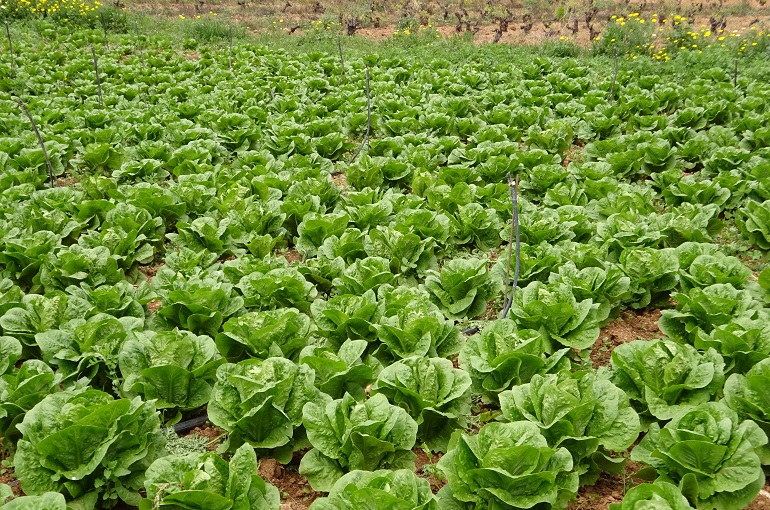Lettuce is a seasonal herb that is considered the world’s most important salad crop.
Origin and distribution of Lettuce
The centre of origin of L. sativa appears to be the middle east.
The first records of lettuce as a vegetable is a long leaved from depicted on Egyptian tombs dated 4500 B.C.
Lettuce was grown by the ancient Greeks and Romans and it spread to China by the seventh century A.D.
lettuce was recently introduced to the tropics and no truly tropical races have been evolved. It is now grown worldwide, in temperateand tropical environments.
Lettuce Ecology
Lettuce is relatively tolerant of a wide range of climatic and soil conditions although well-drained, sandy loams, with a pH of 6.0-6.8 are generally preferable.
Adequate watering is also essential. Cultivars which are specifically adapted to tropical environments have been hybridized or selected for many ecological regions.
Many are tolerant to high day temperatures of up to 30°C and short days although the most suitable range for most cultivars is 15-20°C.
High temperatures often result in premature flowering, stunted leaf growth and bitter tasting leaves.
Elevations above 1000m provide good conditions for optimum growth. In the tropics, lettuce grows well at higher altitudes.
Lettuce Botany
An annual lactiferous herb forming a dense basal rosette and later tall branched, flowering stems, 30-100cm tall.
The leaves are large, more or less crinkled, and sometimes lobate, varying in color from pale green to occasional purple and almost sessile.
The rosettes of cabbage lettuce are sometimes very compact.
When lettuce plants flower, they produce yellow hermaphrodite flowers, 0.5 to 1cm wide and attached to a branched stem.
Bolting or flowering renders the leaves unfit for human consumption as they develop a bitter taste.
Also, the seeds are flat, beige to brown in colora and about 2mm long. They are surmounted by a pappus. It has a taproot, which develops quickly at first slender, but later thickening, growing to a depth of about 1.5m.
Different Varieties of Lettuce
In general, four varieties of lettuce are recognized:
1. L. sativa L. var capitata L. (cabbage or butter-head or head lettuce). This is the most popular and most widely grown.
The rosettes of leaves curl around each other forming a very compact cabbage-like rounded head.
2. L. sativa L. var. longifolia Lam.
The leaf rosettes are cylindrical or conical with prominent midribs in the leaves.
Most cultivars are self folding, forming loose oblong hearts.
3. Var crispa L.- Leaves similar in texture and in appearance of midribs to cabbage lettuce but are sometimes name ‘curled’ lettuce.
4. Var asparagina Barley- The young fleshy stems are used, usually cooked, and not the leaves which are coarse and unpalatable.
This variety is grown almost exclusively in China.
Cultural practices of Lettuce
Propagation is from seed, which germinates in 4-5 days days from sowing.
Seeds may be sown in drills 25-30cm apart and seedlings initially thinned to 8-10cm, later to 20-25cm apart in the row.
Approximately 0.75kg of seed is required per hectare to give a planting density of 20,000 plants/ha.
The plant does not produce much seed in the tropics, and gardeners are often obliged to buy imported seeds produced by specialized seed firms.
Lettuce is more frequently down in containers or a seedbed in nurseries and transplanted when 4-6 weeks old.
In some areas, black polythene mulch is used to reduce water evaporation from the soil surface.
Lettuce responds well to organic manures and to top dressings of fertilizers.
Irrigation is required at frequent intervals, particularly at transplanting and until the seedlings are established.
Dry conditions are likely to induce premature flowering.
How to Harvest Lettuce
Most heading cultivars mature within 60-85 days from transplanting but the loose leaf types may be ready for harvesting within 35-50 days from planting.
The method of harvesting depends on the type of plant cultivated, heading or leafy.
The heading types (cabbage lettuce) are harvested whole, whereas the tender leaves of leafy varieties are picked as they mature.
Harvesting during the early part of the day is preferable, particularly in hot weather.
Plants which become mature and are allowed to flower will normally form viable seed.
Lettuce Yields
Approximately 5-15t/ha of leaf yield can be obtained. Seed yield of 120kg/ha can be obtained.
How to Store Lettuce
The leaves of harvested lettuce should be fresh and free of discoloration.
Open-topped polythene bags are used to present moisture loss and reduce damage; they also allow for wetting of the heads to retain turgidity.
At temperatures of 0-3°C, heads may remain in good condition for up to 14 days at a relative humidity of 90-95%. Also, weight loss may be up to 15%.
In technologically advanced countries, especially the united States, lettuce can be trimmed and then carefully packed and iced for shipment.
It may be vacuum cooled before transportation across the country in containers.
Seeds can be stored for up to 4 years at a relatively low temperature and humidity.
Uses of Lettuce
It is normally used in the raw state in salads but also as cooked vegetable, particularly in South-East Asia.
Lettuce leaves contains the following in the possible proportion
95% water,
1.2% protein,
0.2% fat,
2.9% carbohydrate, and
0.7% ash.
They are rich in vitamins A and E, and minerals such as Ca, P, Na, Mg and K.
Loose-headed forms have higher vitamin A content than heading cultivars.
Diseases and Pests of Lettuce
Pythium spp. causes damping-off of seedlings and rotting of the leaves.
Other diseases of lettuce include downy mildew caused by Bremia lactucae, leaf spots by Cercospora lactucae and Septoria lactucae.
Slugs and snails can also be troublesome. Lettuce mosaic virus has been reported.








